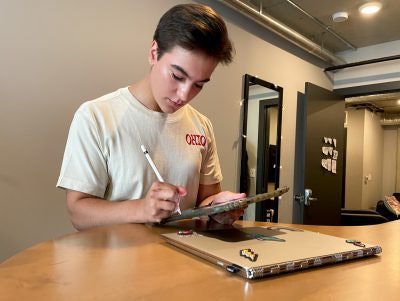A few weeks into the fall semester of 2020, Mary Trabue already felt the waves of exhaustion and isolation from online lectures hit her. She was in her third undergraduate year at The Ohio State University (OSU), studying biological engineering. A usually motivated student, Trabue began noticing herself slowly disengaged.
“Every day felt the same: waking up, walking over to my computer, listening to a lecture. Repeat. I saw no end in sight,” said Trabue, who kept drifting through the fall until a new semester neared. “Once the spring semester was about to start, I knew those feelings would come back. I dreaded it. My fears were in a way confirmed.”
 Ohio State University student Mary Trabue studies at her home near campus. She sought a counselor after her anxiety grew in the pandemic.
Ohio State University student Mary Trabue studies at her home near campus. She sought a counselor after her anxiety grew in the pandemic.Trabue took five rigorous classes in spring 2021, all in STEM. Some were hybrid, which Trabue said helped somewhat with her motivation, but she still was socially distanced from her peers. It remained tough to find a community or ask for help.
“A few other things were going on in my life. I had a big breakup on top of the isolation. I started to have a hard time getting out of bed,” said Trabue, who knew something was wrong. “When I felt disconnected from my academics and from that personal relationship, I reached out to a counselor at Ohio State to talk to someone. I didn’t feel like that driven student I used to be.”
Like many of her peers, Trabue was suffering from anxiety. According to a recently released survey from OSU’s Office of the Chief Wellness Officer, OSU students reported higher rates of anxiety, depression, and burnout in April 2021 compared to August 2020 when online or hybrid learning started.
 Dr. Bernadette Melnyk
Dr. Bernadette MelnykThis spike unfortunately did not surprise the Chief Wellness Officer Dr. Bernadette Melnyk, who is implementing changes on OSU’s campus to better prevent rather than react to mental health challenges like those Trabue experienced.
“Even before the pandemic, surveys by the American College Health Association showed very high rates of anxiety and depression in students. And that was prior to the social, racial, and political tensions we’ve seen on top of COVID-19 and isolation,” said Melnyk, who is also president of the National Consortium for Building Healthy Academic Communities. “We now have a mental health pandemic inside of the COVID-19 pandemic.”
OSU enrolls more than 66,000 students across its professional, graduate, and undergraduate schools. In August 2020, 40% of a random sample of students surveyed reported burnout. But in April 2021, from the same random sample of students, 71% said that they felt overwhelmed. In addition, Black and Hispanic students reported disproportionately higher rates of anxiety and depression compared to their white peers. The survey also found that students were coping in more unhealthy ways, including increased vaping and alcohol use alongside decreased physical exercise and healthy eating.
“Mental health is an unattended-to issue in many places until there’s a crisis like a suicide,” said Dr. Amy Reynolds, a professor of counseling at the University at Buffalo who specializes in college student mental health. As Melnyk noted, Reynolds said the OHU survey’s findings are part of a bigger, national trend in higher education, one she calls a silent epidemic.
“Students who had mental health challenges before the pandemic struggled more. And those who didn’t have a history struggled for the first time because of COVID. The stress and isolation in the pandemic and the racial reckoning amplified mental health concerns in some students and generated them in others,” said Reynolds, who noted each student’s circumstances are different. “There is not a uniform one-size-fits-all as to what made this year so difficult.”
 Dr. Amy Reynolds
Dr. Amy ReynoldsIn response to their survey findings as the new academic year approaches, Melnyk is expanding evidence-based programs and resources for students. The university is also bringing more resources into the curriculum, such as teaching students mindfulness exercises and cognitive-behavioral skills for stress reduction.
After Trabue sought support, she found talking to a counselor validated her feelings and helped her develop healthy coping tools. Joining a weight lifting community especially helped her as well as learning breathing techniques.
“It’s called 54321. I start with five things I can see around me, four things I can feel, three things I can hear, two things I can smell, and one thing I can taste. That helps calm me,” said Trabue, who uses the method if she feels an anxiety attack coming. “It’s so important to take care of yourself. Doing something you really enjoy, even for a few minutes each day, can really prevent that burnout feeling.”
OSU built a mental health checklist for students to find similar strategies. The checklist, called “five to thrive,” includes establishing healthy stress reduction habits and growing as well as maintaining support systems.
“There is hope. The key is equipping students with skills that we know can work,” said Melnyk. “We need to shift our emphasis from crisis intervention to prevention. And every university in the country needs a chief wellness officer, somebody primarily concerned with creating a culture of wellbeing. Self-care is not selfish. It’s not a nicety. It’s a necessity.”
Reynolds agrees in fostering cultural change on campuses to meet students’ needs, particularly among students of color.
“Quite frankly, everyone keeps saying go back to normal, but normal is not good enough, especially for marginalized students,” said Reynolds. “My fear is that faculty will go back to their usual demands and expectations. I feel that’s not warranted. We need to continue to give students grace for them to be fully human, to be students among the many other parts of who they are.”
Trabue also had words of advice for students and faculty to improve mental health awareness and response in the year ahead.
“To students, don’t be afraid to reach out if you need help,” said Trabue. “And to faculty, stay attuned to your students. Maybe ask them how overwhelmed they feel, if you can cut back on some of their assignments. And tell them there are resources out there that can help.”


















